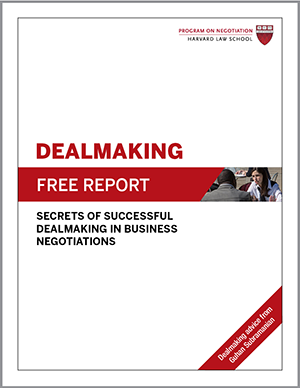
Here are some concrete guidelines for fostering a strong relationship between dealmaking partners, drawn from The Global Negotiator: Making, Managing, and Mending Deals Around the World in the 21st Century, by Tufts University professor Jeswald W. Salacuse:
Dealmaking Tip 1. Start Forming a Relationship Before You Sign the Contract
While negotiators must necessarily be concerned about a deal’s contractual provisions, they should also lay a solid foundation for a negotiation relationship from the very start of talks.
Unfortunately, many dealmakers do not.
In one survey, Jeswald Salacuse asked American executives whether their primary dealmaking goal was to reach a contract or to start a relationship.
Fifty-four percent were focused on hammering out a contract. Their chances for a successful deal would be far better if they thought of themselves as relationship negotiators, not just contract makers.
Before sitting down at the bargaining table, you might also consider hiring a consultant to develop and guide a program of relationship-building activities, which could include joint workshops, get-acquainted sessions, and retreats for executives from both sides.
(See also: BATNA: Best Alternative to a Negotiated Agreement)
Dealmaking Tip 2. Select the Right People to Manage the Relationship
Launching a business relationship requires diplomacy as well as technical expertise. To lay a solid foundation for the relationship, each side should select negotiators with the appropriate interpersonal skills, knowledge, and sensitivity.
Indeed, these qualities are more important in the long run than the technical knowledge of engineering, marketing, or finance experts. Just as diplomats must be vetted by the receiving state, parties to alliances might agree that executives appointed to manage the relationship in a negotiation should receive the approval of the other side.
Dealmaking Tip 3. Closely Involve Negotiators in Deal Implementation
Too often, companies signing a long-term contract assume that a solid working relationship will develop automatically. For example, General Motors negotiated a series of joint ventures that ran into trouble once GM and its international partners began working together.
Why?
Because the teams that were negotiating the deal were not the ones in implementing it. After GM negotiators formed a joint venture, they’d move on to the next deal, leaving other executives with the task of figuring out how to make it work.
During dealmaking, both sides gain an enormous amount of information about each other and the deal. In the process, they may very well form a positive relationship. To mobilize these valuable assets, the negotiators themselves should play a role in implementing the transaction, at least from the beginning.
Dealmaking Tip 4. Work to Keep Leaders Involved and Interested in the Relationship
Many deals are made with the active involvement of the companies’ leaders, whose personal relationship becomes a foundation for the relationship between the two organizations. After the contract is signed, it’s important to find ways to maintain management’s visible interest.
Try scheduling periodic meetings for leaders to review the evolution of the relationship between their companies.
For example, a deal to produce imaging devices might call for semiannual meetings between the heads of your two firms, alternating between the cities where they are based.
Dealmaking Tip 5. Educate Company Personnel About the Deal
Don’t assume that others in your firm will become as enthusiastic and knowledgeable about the deal as negotiators are. Indeed, others may view involvement with another company – whose culture and business practices they may not understand – as a burden, or even a threat.
Inevitably, those implementing any deal will encounter difficulties, such as delivery delays, failed technologies, and miscommunication.
Both sides will be better able to overcome these problems if their employees know and trust one another than if they view the other side with suspicion and hostility.
To overcome resistance within their organization, deal advocates should plan educational efforts that bring employees from the two firms together, such as meetings, retreats, seminars, site visits, and jointly produced memorandums and newsletters.
Remember: organizational relationships begin with personal relationships.
Dealmaking Tip 6. Meticulously Plan and Oversee Initial Joint Activities
Just as opening moves in the dealmaking process can either facilitate or hinder the steps that follow, initial joint activities between contractual partners can either ease or obstruct the creation of a productive working relationship.
Consequently, the two sides should carefully define and supervise the first moves in their relationship.
Don’t assume that everything will flow smoothly from the contract terms. It may be better to start small, with actions that are sure to succeed, before moving on to more ambitious projects. Before beginning the full-scale production of new imaging devices, for example, you would certainly first want to make and test a prototype.
Dealmaking Tip 7. Agree on a Schedule of Meetings to Review Progress
Although a business relationship is organic and evolves over time, this doesn’t mean that the two sides should not consciously shape it. To guide the evolution of a sound relationship, both companies should adhere rigorously to a regular schedule of meetings, rather than just meeting from “time to time” or “when the need arises.”
Related Dealmaking Article: Dealmaking – Relationship Rules and Business Negotiations
Originally published in 2013.






You need tools to track the evolution of the relationships between two companies. Irish startup Datahug’s product (http://www.datahug.com) can tell you whether existing relationships have strengthened or expanded (more individual relationships than before the contract was signed) over the lifetime of a partnership. It analyses company email and VOIP headers and calendar info to track relationships in real time based on the latest interactions.